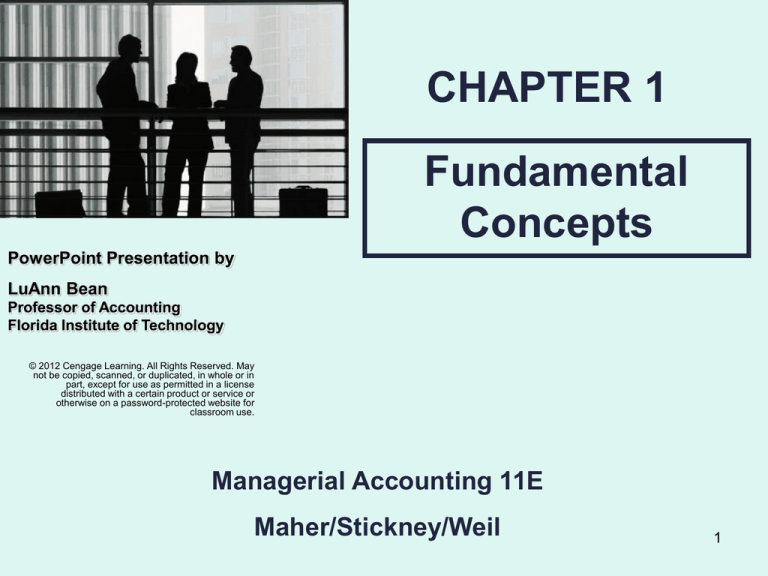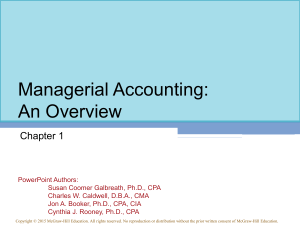
CHAPTER 1
Fundamental
Concepts
PowerPoint Presentation by
LuAnn Bean
Professor of Accounting
Florida Institute of Technology
© 2012 Cengage Learning. All Rights Reserved. May
not be copied, scanned, or duplicated, in whole or in
part, except for use as permitted in a license
distributed with a certain product or service or
otherwise on a password-protected website for
classroom use.
Managerial Accounting 11E
Maher/Stickney/Weil
1
☼
CHAPTER GOAL
☼
This chapter provides the groundwork for the
book, including tying strategic cost analysis to
the value chain.
2
LO 1
FINANCIAL ACCOUNTING:
Definition
Reports to users
(shareholders, creditors,
financial analysts, etc.)
outside the organization.
3
LO 1
MANAGERIAL ACCOUNTING:
Definition
Reports results of activities
to insiders (managers, etc.).
4
LO 2
When a product is a
“commodity” how do you
compete to achieve/maintain
profitability?
Compete by differentiating
yourself from competition. Focus
on order fulfillment, cutting
costs, etc.
5
LO 2
Can/should the financial or tax
accounting systems be used for
managerial accounting
purposes?
NO! The objectives and
therefore the information
available for decision making is
different.
6
LO 3
FINANCIAL PROFESSIONALS
Financial VP: in charge of all accounting and
finance
Controller: manages cost and managerial
accounting
Treasurer: manages cash flows; raises cash
Cost accountants/managers: analyze,
manage costs
Internal audit: provides auditing, consulting
services
7
LO 4
ETHICAL, REGULATORY
FRAMEWORK
Standard setting
Cost Accounting Standards Board sets cost accounting
standards
Professional organizations
Institute of Management Accounts (IMA) sponsors
professional certifications
Certifications
Certified Management Accountant (CMA)
Certified Public Accountant (CPA)
Canadian certifications
Chartered Accountant (CA)
Certified General Accountant (CGA)
8
LO 4
PREVENTING WHITE COLLAR
CRIME
Sarbanes-Oxley Act
Passed in the aftermath of the Enron scandal
Includes
Making CEOs and CFOs sign and accept responsibility
for financial statements
Making CEOs and CFOs responsible for the company’s
system of internal controls
Creating the Public Company Accounting Oversight
Board to oversee public auditors
9
LO 5
TYPES OF COSTS
Opportunity costs
Is the forgone income from using an asset in its best
alternative
Direct costs
Relate directly to the cost object for which cost is to be
measured
Indirect costs
Are indirectly related to the cost of a cost object
Variable costs
Change in total as the level of activity changes
Fixed costs
Do not change in total with changes in the level of activity
10
LO 5
How do costs and
expenses differ?
While a cost is the sacrifice
of resources, an expense is
a “gone” asset.
11
LO 6
Variable and fixed
costs lumped together
for financial
purposes.
EXHIBIT 1.3
EXHIBIT 1.2
Variable and fixed
costs are presented
separately for
managerial purposes.
12
LO 7
ACTIVITY BASED
MANAGEMENT (ABM): Definition
Examines activities and their
associated costs as a means of
developing efficiencies and
reducing non-value-added
costs.
13
LO 7
What are “non-valueadded” activities?
Non-value-added
activities are activities that
can be eliminated without
reducing a product’s
service potential to the
customer.
What are “value-added”
activities?
Value-added activities
are activities that
increase a product’s
service to the customer.
14
LO 7
VALUE CHAIN: Definition
Describes a linked set of
activities that increase the
usefulness (value) of
products/services of an
organization.
15
LO 7
Functions of the
value chain help
management
identify value-added
activities.
EXHIBIT 1.4
16
LO 7
How do strategic and
tactical cost management
decisions differ?
Strategic decisions choose
between production
alternatives. Tactical decisions
make a particular production
alternative more cost efficient.
17
LO 7
STRATEGY and VALUE
CHAIN
Strategic cost analysis identifies parts
of the value chain that generate
most profits, enabling management
to position their business at the best
profit points.
18
LO 7
ECONOMIC DEPRECIATION:
Definition
Measures decline in value
of assets during a period
using either sales value or
replacement cost.
19
LO 7
COST OF CAPITAL: Definition
Is the amount a firm could
earn on its assets by
putting them to their best
alternative use.
20
LO 8
KEY DEVELOPMENTS IN
MANAGERIAL ACCOUNTING
Integrated information systems
Tie managerial accounting, financial reporting, customer
databases, supply chain management and other databases
together
Examples: ERPS, SAP
Web hosting
Allows companies to focus on core competencies while
outsourcing portions of information systems
Just-in-Time (JIT) and lean production
Eliminate inventory between production departments and
focus on quality and efficiency
Continued
21
LO 8
KEY DEVELOPMENTS IN
MANAGERIAL ACCOUNTING (cont.)
Total quality management (TQM)
Measures product reliability and service delivery as well as
profitability while attempting excelling in all dimensions
Theory of constraints (TOC)
Identifies the weakest part of the process chain (constraint)
and attempts to improve it
Benchmarking and continuous improvement
Benchmarking: continuous process of measuring products,
services, activities against best performance levels,
engaging in continuous improvement
Fads
22
LO 9
INFORMATION
Information is not free. Management
must consider costs and benefits of
information when designing an
optimal accounting system.
23
LO 10
The Institute of Management Accountants
promulgated the following standards of ethical
conduct for management accountants.
1.
2.
3.
4.
COMPETENCE - ongoing development of their
knowledge and skills in preparing complete reports with
relevant and reliable information.
CONFIDENTIALITY – do not disclose confidential
information acquired in the course of their work, except
when authorized.
INTEGRITY - Avoid actual or apparent conflicts of
interest.
OBJECTIVITY - Communicate information fairly and
objectively.
24
LO 10
RESOLUTION OF ETHICAL CONFLICT
1. Discuss such problems with the immediate superior except when
it appears that the superior is involved, in which case the problem
should be presented initially to the next higher managerial level.
2. If the immediate superior is the chief executive officer or
equivalent, the acceptable reviewing authority may be a group
such as the audit committee, executive committee, board of
directors, board of trustees, or owners.
3. Clarify relevant concepts by confidential discussion with an
objective advisor to obtain an understanding of possible courses
of action.
4. If the ethical conflict still exists after exhausting all levels of
internal review, the management accountant may have no other
recourse on significant matters than to resign from the
organization and to submit an informative memorandum to an
appropriate representative of the organization.
25
End of CHAPTER 1
26









